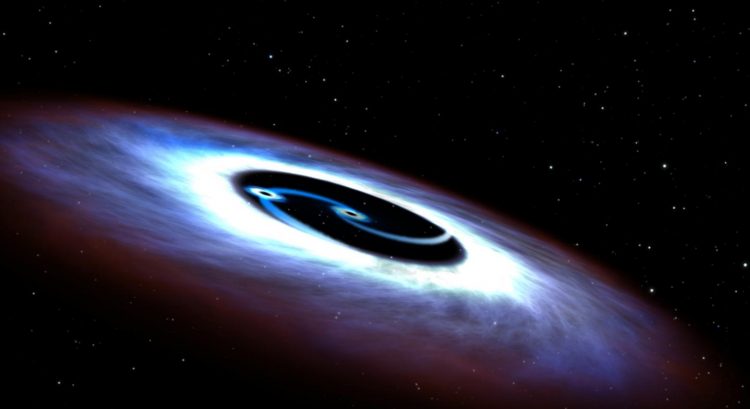OU astrophysicist and collaborators find supermassive black holes in quasar nearest Earth

OU astrophysicist and his Chinese collaborator used observations from NASA's Hubble Space Telescope to find two supermassive black holes in Markarian 231. Credit: Space Telescope Science Institute, Baltimore, Maryland
The discovery of two supermassive black holes–one larger one and a second, smaller one–are evidence of a binary black hole and suggests that supermassive black holes assemble their masses through violent mergers.
Xinyu Dai, professor in the Homer L. Dodge Department of Physics and Astronomy, OU College of Arts and Sciences, collaborated on this project with Youjun Lu of the National Astronomical Observatories of China, Chinese Academy of Sciences.
Dai and Lu looked at ultraviolet radiation emitted from the center of the Mrk 231 from Hubble observations, then applied a model developed by Lu to the spectrum of the galaxy. As a result, they were able to predict the existence of the binary black holes in Mrk 231.
“We are extremely excited about this finding because it not only shows the existence of a close binary black hole in Mrk 231, but also paves a new way to systematically search binary black holes via the nature of their ultraviolet light emission,” said Lu, National Astronomical Observatories of China, Chinese Academy of Sciences.
“The structure of our universe, such as those giant galaxies and clusters of galaxies, grows by merging smaller systems into larger ones, and binary black holes are natural consequences of these mergers of galaxies,” said Dai.
So over time, the two black holes discovered by Dai and Lu in Mrk 231 will collide and merge to form a quasar with a supermassive black hole. A quasar is an active galaxy with an illuminated center, which is short lived compared to the age of the universe.
###
The results of this project were published in the August 14, 2015, edition of The Astrophysical Journal. For more information about this project, please contact Xinyu Dai at xdai@ou.edu.
Media Contact
All latest news from the category: Physics and Astronomy
This area deals with the fundamental laws and building blocks of nature and how they interact, the properties and the behavior of matter, and research into space and time and their structures.
innovations-report provides in-depth reports and articles on subjects such as astrophysics, laser technologies, nuclear, quantum, particle and solid-state physics, nanotechnologies, planetary research and findings (Mars, Venus) and developments related to the Hubble Telescope.
Newest articles

Why getting in touch with our ‘gerbil brain’ could help machines listen better
Macquarie University researchers have debunked a 75-year-old theory about how humans determine where sounds are coming from, and it could unlock the secret to creating a next generation of more…

Attosecond core-level spectroscopy reveals real-time molecular dynamics
Chemical reactions are complex mechanisms. Many different dynamical processes are involved, affecting both the electrons and the nucleus of the present atoms. Very often the strongly coupled electron and nuclear…

Free-forming organelles help plants adapt to climate change
Scientists uncover how plants “see” shades of light, temperature. Plants’ ability to sense light and temperature, and their ability to adapt to climate change, hinges on free-forming structures in their…





















